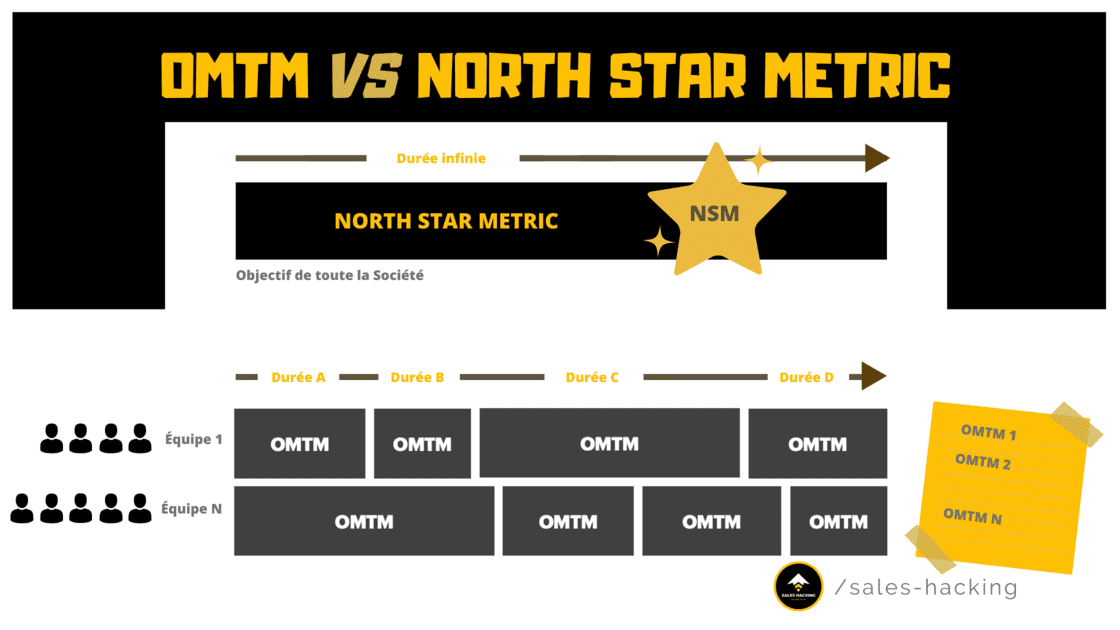What is the North Star Metric?
The North Star Metric (NSM) is a measure that a business uses as a benchmark for growth. This metric best reflects the value your business brings to your customers.
Additionally, the North Star gives direction to the long-term growth of your business compared to short-term growth.
The well-known examples of North Star Metric are as follows:
- Spotify: “Time spent listening”
- Airbnb: “Number of nights booked”
- Facebook: “Monthly Active Users”
- And I've listed many more examples of below North Star Metric.
La North Star Metric is that the value delivered to your customers and growth are correlated. Indeed, if your customers receive value from your products or services:
- they will be more faithful,
- they will buy more,
- they'll recommend more people,
- you will get more customers.
If your Business is growing, your North Star will be growing also thanks to an improvement in all stages of the Pirate Funnel.
Optimize Your Growth Strategy
The “North Star Metric” (NSM) represents a central element in a company's growth strategy, serving as a beacon to guide all efforts towards a common goal. This unique metric, which differs from OMTM (One Metric That Matters) oriented towards short-term goals, aims to ensure consistent, long-term growth by focusing on added value for the customer.
North Star Metric benefits
- Unified objective: The NSM provides a clear and common objective for the entire company, while the OMTM focuses on team-specific goals, contributing indirectly to the global NSM.
- Clarity and Customer Orientation: The NSM offers a clear vision of growth and focuses on providing value to the customer, promoting the retention and optimization of all stages of the Pirate Funnel.
- Focus on results: Adopting an NSM leads to more effective business development, improving sustainability, accelerating customer conversion, and increasing customer lifetime value (LTV) while reducing customer acquisition cost (CAC).
READ MORE: Ultimate Guide to Key Performance Indicators to Measure
Choosing and Using the North Star Metric
- Predicting Success: The NSM should be a leading indicator of future success, rather than just a measure of past performance.
- Reflection of the value provided: NSM should be closely linked to the real impact on customers, not based on superficial metrics like the number of active users.
Famous Examples
I would like to make it easier for you by sharing some examples of North Star Metrics from major companies to give you ideas in choosing your NSM:

1. facebook
Facebook's North Star Metric is often confused.
From the very beginning, Mark Zuckerberg used the”active users per month“like North Star Metric.
People are often wrong about this: Facebook's North Star Metric isn't what you'd typically hear, which is:”get 7 friends in 10 days”. It's actually their “WOW” moment!
2. Spotify
Spotify's NSM is “time spent listening.”
According to Mayur Gupta, head of growth at Spotify.
What is so good about Spotify's North Star Metric?
- It measures the value that customers derive from the platform.
- If the Pirate Metric increases, so will the NSM
3. Amazon
Amazon has as North Star Metric the “number of purchases per month per customer.”
It is a logical example of a measurement that is generally used by many e-commerce businesses.
4. AirBnb
AirBnb's North Star Metric is the “number of nights booked.”
It combines tenant and owner value perfectly, so it's a good North Star Metric for this type of platform.
5. LinkedIn
Before the takeover by Microsoft
LinkedIn's North Star Metric has long been the”number of recommendations given“between users.
It proved that users were less likely to delete their profile (since it obtains great value) and that therefore recruiters obtained more information about potential candidates through the platform.
After the takeover by Microsoft
After the takeover by Microsoft, LinkedIn chose to use Facebook's NSM as an example and choose the”number of active users“per month as a reference metric.
6. WhatsApp
WhatsApp's North Star Metric is the”number of messages sent“.
In addition to the number of active users, this MSM also offers a vision of the level of use of the platform per user.
7. Uber
Uber's North Star Metric is the”Number of races per week“.
It is quite similar to the NSM from AirBnb. This is common for Marketplace business models where buyers and sellers need to jointly take advantage of the platform.
8. Hubspot
Hubspot's North Star Metric is “the number of active teams each week.”
Below is the breakdown of this North Star Metric (in English):

9. Slack
La North Star Metric by Slack is “Number of messages sent” or the “number of daily active users,” but web sources don't provide a definite answer.
Personally, I would say that the “number of users per day” would be best suited to an email software because the aim is not necessarily for people to send a lot of messages, but above all that they send them in the most efficient way possible: This can mean sending fewer messages.
Why is revenue a bad North Star Metric?
The danger of using revenue as an NSM is that you might be more concerned with getting your customers to pay as much money as possible in the short term.
- Revenue is the price your customers pay for your products or services.
- La North Star Metric is the value that your customers get in return for this rate.
A customer who Benefit from the value of your product or service will be more faithful and will probably pay a lot more in the long term.
In a way, the increase in sales is the result of a rapidly growing North Star Metric.
Ultimately, the North Star Metric is not only a measure of current performance, but a guide to sustained and significant growth.
It requires a deep understanding of the impact of your business on its customers and requires a long-term commitment to guide and inform business strategies. Choosing the right NSM and aligning it with the company's mission and values is crucial to ensure that all efforts contribute to consistent and sustainable growth.
Difference between NSM and OMTM
Too many people confuse NSM (North Star Metric) and the OMTM (One Metric That Matters).
However, they are related but different metrics, as we will see by studying their respective characteristics.

NSM - North Star Metric
- It does not exist Only one North Star Metric for the whole company (from the After-Sales Service to the IT Department, etc.)
- It is indicative of the value provided to customers (and therefore of growth)
- Each team in your company contributes to maximizing it.
- The North Star Metric won't change unless you change your business model
OMTM - One Metric That Matters
- It exists SEVERAL One Metric That Matters for the company
- They contribute to the growth of North Star Metric
- Different teams may have different OMTMs
- It is used by a team of 3 to 6 employees to materialize the results of rapid experimental phases on short/medium term objectives.
- On average, OMTMs change every 2 to 6 months.
In short: the OMTM are subsets of the North Star Metric (NSM). Each team has an OMTM that has an indirect impact on NSM.
Guide to defining the North Star Metric
A good North Star Metric meets various criteria that we will look at together to prevent you from making a quick mistake.
1. Proportional to the “success” phases of your customer.
If you do it right, your North Star is right when the customer realizes the added value of your product/service/software (called the WOW moment)
For example:
- instagram: This is when a person feels listened to (a Comment or Like from a community member on their post) or when they are entertained (by engaging in someone else's posts).
- dropbox : this is the moment when someone places their first file on the Cloud and can use it effortlessly (Edit a file, Comment, Share, etc.),
- AirBnb : This is the time when you have easily found a trip or your apartment is booked by a user.
2. Value provided to the customer.
A good NSM ensures that you are attentive to all the KPIs in your Pirate Funnel.
Data such as “the number of orders placed” does not highlight customer satisfaction and therefore cannot be used as an NSM. If the customer does not receive any benefit from your products or services, they will no longer order from you.
On the other hand, a good North Star Metric could be: “the number of packages delivered without a complaint.”
You need to look for the perfect balance between measuring customer satisfaction and keeping it measurable for you.
3. Key practices
To define a North Star Metric that effectively guides your growth strategy, it is crucial to focus on three fundamental aspects: measurability, time limitation, and control.
Measurability: Choose indicators that are tangible and meaningful.
- Opt for concrete measures that represent added value.
- Verify that the data is really indicative of benefits for users.
Time limitation: Set a specific time frame for evaluating NSM.
- Frame the NSM in a time context (day, month, etc.).
- Use this period as a tool to compare and assess growth.
Control: Ensure that your NSM is directly influenced by your actions.
- The NSM must be independent of external factors, focused on the customer-business relationship.
- Ensure that NSM accurately reflects the impact of your business on its customers.
By adopting these practices, you will be able to establish a North Star Metric that not only guides your growth, but also ensures continuous and significant improvement in your business.
4. A direct reflection of your growth.
However you look at it, if your North Star Metric is growing, that means your business is also growing.
For this reason, it should not be a “Vanity metric”: a value that makes you “happy” but which in no way reflects the value provided.
Let's take 2 examples to illustrate this:
- ❌ NSM: “the number of visitors per week who added an item to their basket”
- ✅ NSM: “the average conversion rate per addition to the basket”
A good North Star Metric is a metric that everyone in your business can influence.
Everyone should feel involved in this growth objective.
5. Steady progress to get quick returns.
If your North Star Metric is only based on periodic events obtained by your customers, it will take too long for you to know if you are on the right track or not.
Ideally, your NSM evolves every day or every week.
It should therefore be an action that each customer must perform regularly (at least four times a month).
READ MORE: List of Growths hacks updated daily
Conclusion
The North Star Metric is more than just a measure; it is the beacon that guides your business to sustainable and meaningful growth.
By focusing on this critical metric, a business can align its efforts, stay aligned with the needs of its customers, and move toward long-term success.
The clarity and direction that North Star Metric provides transform growth strategies into consistent, goal-oriented journeys.
In summary, understanding and integrating North Star Metric into your strategy is a decisive step towards reaching your full growth potential and strengthening your market position.

.svg)


.avif)

